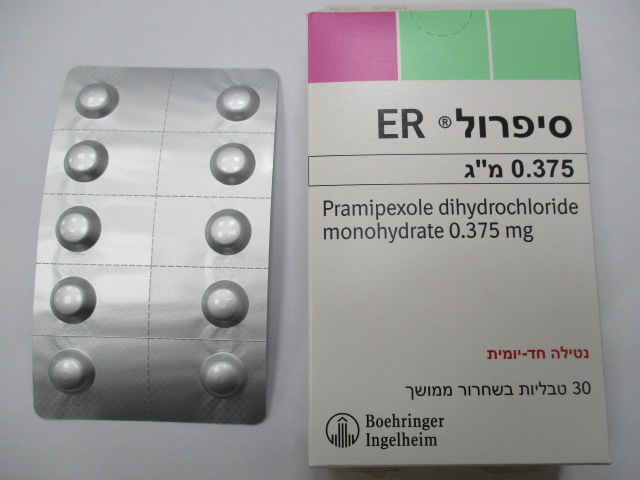Quest for the right Drug

סיפרול ER 0.375 SIFROL ER 0.375 mg (PRAMIPEXOLE DIHYDROCHLORIDE MONOHYDRATE)
תרופה במרשם
תרופה בסל
נרקוטיקה
ציטוטוקסיקה
צורת מתן:
פומי : PER OS
צורת מינון:
טבליות עם שחרור נרחב : TABLETS EXTENDED RELEASE
עלון לרופא
מינוניםPosology התוויות
Indications תופעות לוואי
Adverse reactions התוויות נגד
Contraindications אינטראקציות
Interactions מינון יתר
Overdose הריון/הנקה
Pregnancy & Lactation אוכלוסיות מיוחדות
Special populations תכונות פרמקולוגיות
Pharmacological properties מידע רוקחי
Pharmaceutical particulars אזהרת שימוש
Special Warning עלון לרופא
Physicians Leaflet
Adverse reactions : תופעות לוואי
4.8 Undesirable effects Based on the analysis of pooled placebo-controlled trials, comprising a total of 1,778 Parkinson’s disease patients on pramipexole and 1,297 patients on placebo, adverse drug reactions were frequently reported for both groups. 67% of patients on pramipexole and 54% of patients on placebo reported at least one adverse drug reaction. The majority of adverse drug reactions usually start early in therapy and most tend to disappear even as therapy is continued. Within the system organ classes, adverse reactions are listed under headings of frequency (number of patients expected to experience the reaction), using the following categories: very common (≥ 1/10); common (≥ 1/100 to < 1/10); uncommon (≥ 1/1,000 to < 1/100); rare (≥ 1/10,000 to < 1/1,000); very rare (< 1/10,000); not known (cannot be estimated from the available data). The most commonly (≥ 5%) reported adverse drug reactions in patients with Parkinson’s disease more frequent with pramipexole treatment than with placebo were nausea, dyskinesia, hypotension, dizziness, somnolence, insomnia, constipation, hallucination, headache and fatigue. The incidence of somnolence is increased at doses higher than 1.5 mg pramipexole salt per day (see section 4.2). A more frequent adverse drug reaction in combination with levodopa was dyskinesia. Hypotension may occur at the beginning of treatment, especially if pramipexole is titrated too fast. Body System Very common Common Uncommon Rare Not known (≥1/10) (≥1/100 to (≥1/1,000 to (≥1/10,000 <1/10) < 1/100) to <1/1,000) Infections and pneumonia infestations Endocrine inappropriate disorders antidiuretic hormone secretion1 Psychiatric insomnia, compulsive mania disorders hallucinations, shopping, abnormal pathological dreams, gambling, confusion restlessness, hypersexuality, behavioural delusion, symptoms of libido disorder, impulse control paranoia, disorders and delirium, compulsions binge eating1, hyperphagia1 Nervous system somnolence headache sudden onset of disorders dizziness sleep, dyskinesia amnesia, hyperkinesia, syncope Eye disorders visual impairment including diplopia, vision blurred, visual acuity reduced Cardiac cardiac failure1 disorders Vascular hypotension disorders Respiratory, dyspnoea, thoracic, and hiccups mediastinal disorders Gastrointestinal nausea constipation, disorders vomiting Skin and hypersensitivity, subcutaneous pruritus, tissue disorders rash Reproductive spontaneous system and penile erection breast disorder General fatigue, dopamine disorders and peripheral agonist administration oedema withdrawal site conditions syndrome including apathy, anxiety, depression, fatigue, sweating and pain. Investigations weight decrease weight increase including decreased appetite 1 This side effect has been observed in post-marketing experience. With 95 % certainty, the frequency category is not greater than uncommon, but might be lower. A precise frequency estimation is not possible as the side effect did not occur in a clinical trial database of 2,762 patients with Parkinson’s Disease treated with pramipexole. Description of selected adverse reactions Somnolence Pramipexole is commonly associated with somnolence and has been associated uncommonly with excessive daytime somnolence and sudden sleep onset episodes (see also section 4.4). Libido disorders Pramipexole may uncommonly be associated with libido disorders (increased or decreased). Impulse control disorders Pathological gambling, increased libido, hypersexuality, compulsive spending or buying, binge eating and compulsive eating can occur in patients treated with dopamine agonists including SIFROL (see section 4.4). In a cross-sectional, retrospective screening and case-control study including 3,090 Parkinson’s disease patients, 13.6% of all patients receiving dopaminergic or non-dopaminergic treatment had symptoms of an impulse control disorder during the past six months. Manifestations observed include pathological gambling, compulsive shopping, binge eating, and compulsive sexual behaviour (hypersexuality). Possible independent risk factors for impulse control disorders included dopaminergic treatments and higher doses of dopaminergic treatment, younger age (≤ 65 years), not being married and self-reported family history of gambling behaviours. Dopamine agonist withdrawal syndrome Non-motor adverse effects may occur when tapering or discontinuing dopamine agonists including pramipexole. Symptoms include apathy, anxiety, depression, fatigue, sweating and pain (see section 4.4). Cardiac failure In clinical studies and post-marketing experience cardiac failure has been reported in patients with pramipexole. In a pharmacoepidemiological study pramipexole use was associated with an increased risk of cardiac failure compared with non-use of pramipexole (observed risk ratio 1.86; 95% CI, 1.21- 2.85). Reporting of suspected adverse reactions Reporting suspected adverse reactions after authorisation of the medicinal product is important. It allows continued monitoring of the benefit/risk balance of the medicinal product. Any suspected adverse events should be reported to the Ministry of Health according to the National Regulation by using an online form: https://sideeffects.health.gov.il.

פרטי מסגרת הכללה בסל
התרופה תינתן בהתקיים כל אלה: א. התרופה תינתן לטיפול בפרקינסון באחת הדרכים האלה: 1. כטיפול יחיד 2. כטיפול משולב עם levodopa ב. לא יינתנו התרופות Pergolide Ropinirole או Pramipexole בו בזמן ג. מתן התרופה ייעשה לפי מרשם של רופא מומחה בנוירולוגיה.
מסגרת הכללה בסל
התוויות הכלולות במסגרת הסל
| התוויה | תאריך הכללה | תחום קליני | Class Effect | מצב מחלה |
|---|---|---|---|---|
| פרקינסון | 01/03/2008 |
שימוש לפי פנקס קופ''ח כללית 1994
לא צוין
תאריך הכללה מקורי בסל
01/03/2008
הגבלות
תרופה מוגבלת לרישום ע'י רופא מומחה או הגבלה אחרת
מידע נוסף
